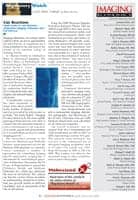 Richard S. Helsper, MBA Richard S. Helsper, MBA |
When I was first recruited to a large tertiary academic center, one of my initial questions to them was regarding my access to the information system and the data contained therein. As I was coming from an entrepreneurial outpatient imaging center environment, I was used to all kinds of data being available at my fingertips. This included volumes (by modality and procedure) and patient demographic (insurance, co-payments, age), as well as referral patterns (office, clinician, receptionist), productivity by equipment and personnel, and the date and time services were provided throughout the encounter. By analyzing prior year, current year aggregate numbers and monthly trending, we were able to see what business lines were up, who was sending us what kinds of patients, and the profitability of each line, thereby identifying problems reflected in a reduction of volumes or other factors. We could see who was doing the work, where we did it, what were our busiest and slowest periods, and at what time we were experiencing system delays and the root cause of those delays. Many systems incorporate a billing function, scheduling, reporting, and some level of inventory tracking. Simply looking at the data was step one; analysis and follow-up on the data proved to be the key to going full circle. We were looking for where we could increase our market share, who were the top drivers of our business (20/80 rule with 20% of people driving 80% of business), and which staff members were most productive and best with delivery of excellent patient care (measured by patient satisfaction, repeat rate, quality of images, minimal callback rate, and throughput).
NO RIS AVAILABLE
Interestingly enough, when I was recruited to Duke University, there was not a radiology information system available. The smaller entrepreneurial sites seemed to be ahead of the curve. For some of the larger academic sites, expense and return on investment (ROI) were not as important in the late 1980s and early 1990s. “Build it and they will come” was a prevalent mentality, while competition was minimal. We had some historical data, but there was no understanding of cause and effect. If changes were implemented, how could we effectively measure the data without extensive manual processes, or a significant delay in the availability of data from the hospital budget office (which arrives in the form of several inches of paper weeks after the fact in monthly aggregate totals)?
Things have changed. Today, we now can obtain information in all kinds of standard reports. If one can think of a question, most likely a report can be written that can provide valuable data to either answer it directly, or supply sufficient data to increase the confidence in any assumptions. The reports we use routinely from our RIS system today are broken down by procedure type, age, turnaround time (TAT), day of week, and time of day, to name a few. These are the general standard reports available on most systems. Through external tools such as relational databases, we can retrieve even more information directly from the RIS or in a separately maintained database and use this for more detailed questions. It is also possible to determine measurements for TAT times. Do you want to look at the time when the appointment is scheduled, patient arrives, procedure completed, or when the case is first interpreted or even electronically final approved? Each data point tells a different story, and looking at all the data points enables the manager to determine where to spend energy and time (both being limited) in order to make the biggest impact to improve services. Perhaps most important, after deciding what to work on and a course of action to improve the timing of any single (and subsequent) data point(s), the RIS system provides a methodology to measure the success (or lack thereof) of any implementation change.
By using the various fields within the system, it is amazing what types of reports are available. One must also remember to comply with all HIPAA regulations, stripping the data so all patient identifiable information is eliminated from the report. We also use data for many research projects, such as the number of people age 18 and under who required a CT brain scan in the emergency department from January through December 31, 2001. We can pull off lists of all procedures that have missing elements, such as unread, not final approved, or missing charges; productivity measures by technologist; TAT; and referral patterns.
34 EXPENSE CENTERS
We sort data in many ways using the information systems available to us. Duke Radiology is composed of 34 expense centers of which 26 generate revenue. Many do only general radiology, others are modality-specific, and a few (imaging center) do many different kinds of procedures. Several of these revenue centers are remote, located some distance from the main hospital. One challenge we face is looking at actual volumes (broken down by procedures, supplies, and miscellaneous charges) compared to budget as well as to the prior year(s). These are basic reports and should be available in most systems. In addition, we need to understand what kind of business (eg, fee for service, Medicare, Medicaid, managed care) it is and whether that business is migrating from one location to another or is growing or diminishing.
We also take the data and re-sort them to use for a variety of other reports, by what we call a procedure classification, (eg, chest, bone, CT, regardless of where performed). In this way, we can easily determine that by moving the CT scanner from the imaging center to the outpatient clinic, the amount of CT volume that was lost at the imaging center was more than made up by doubling the volume in the clinic on the same scanner. This example seems simple; however, explaining why one cost center is below budget while another is above can be challenging in a system with the size and scope of Duke University Health System. Making strategic decisions on where to invest scarce capital dollars (infrastructure, replacement, upgrades, new or expanded service lines) requires a thorough understanding of trends. Submitting complete business plans that result in hitting realistic volume projections encourages further investments. If the administration believes that your data is accurate, frequently greater latitude is given in the decision process in future projects.
Because many reports available in most RIS systems are generic, those organizations that desire to use the information most effectively need to go a step beyond. This can be done through the RIS vendor for a fee, or with an internal analyst, to continue to explore new ways to sort and review the data. I find myself asking our analyst a new query almost every week. Many are dead ends and do not answer the question at hand, but sometimes they will lead to new or unexpected results. We have found that the simple generic reports may not demonstrate the whole picture.
For example, the volume of 7000 CPT codes in our vascular and neuro-interventional laboratories have remained relatively flat for 2 years. This did not translate to what the manager was saying their business was doing. As everyone reading this article knows, Centers for Medicare & Medicaid Services (CMS) requires frequent updates in coding practice to remain compliant, and the volume of charges and amount of work may not always be directly aligned with each other. By focusing on other aspects such as number of cases, cumulative time of patient table time, and changes in surgical coding as a result of Medicare Bulletins and other policies, we determined that volume was very different from first impressions. This resulted in more effective planning for future growth.
An issue that plagues us all is a change in volume due to migration of referring clinicians to new locations and whether their patients end up being seen for their imaging needs within the health system or outside. A related question is whether patient dissatisfaction is the cause due to accessibility (or lack thereof), aesthetics, staffing, and other issues. If a high referrer suddenly stops sending volume, it is critical to have a follow-up conversation with that individual to see if there is an issue (perceived problem in which service recovery steps are required) or possibly something as innocuous as a break in referrals due to the referrer’s vacation.
In some hospitals, by working with the finance people, it is possible to link the RIS data to expected reimbursement rates (Ambulatory Payment Classifications, third-party payments, and inpatient associated with DRGs). This adds to capital business plan accuracy and better strategic planning on where to focus energy. Once the linkages are made in a database, pulling reports from any RIS system and integrating with new information become a relatively simple accommodation.
ACCESS TO DATA
North Carolina is a certificate-of-need state, and a tremendous amount of information is required in the application to the state for purchase of major medical equipment. This includes a full business plan that incorporates historical data as well as projections and all assumptions used in these projections. Having the historical data by system from your RIS in an electronic format is the only way in which any reasonable analysis can be made. Other reports to the state for the annual licensure are also required and that data is easily accessible from a good information system.
Productivity is more important than ever, with the current labor shortages. Understanding who is doing the work, the time it takes, and whether specific scanners run more efficiently (due to staffing changes, referral patterns, location, equipment functionality) allows the radiology administrator to more effectively make decisions and provide retrospective data to support that decision. Adding new staff is always a difficult proposition in today’s environment with hospital administration and cost restraints. The radiology administrator can demonstrate through modeling of data from the RIS that by adding (or moving) staff, volumes can be increased resulting in a reduction in the cost per procedure. This data makes the argument much more effective.
One can also model with a good RIS what time of day and day per week that work is being completed in the various modalities and areas of operation. This allows a more effective decision process when determining optimal hours of staffing and which locations can be most effective. Reviewing the trends of peaks and valleys allows radiology administrators to maximize the effectiveness of their decisions. Once changes are implemented, again, review of effectiveness of any decision must be made following the changes to determine its success.
We use the TAT figures for our reports to demonstrate areas that require attention and could result in significant improvements with the implementation of a voice recognition system. Many efficiencies are possible with voice recognition: looking at the various data points allowed us to further refine and focus our attention on those areas in which we could have the greatest impact. Our TAT was dramatically reduced and our referring customer base was thrilled. The data also has provided us with the required information when complaints come through regarding report delays. Having the data in the RIS to accurately determine where the breakdown may have taken place permitted us to look at what steps were necessary to reduce or prevent future occurrences.
As the data points available to the radiology administrator within a RIS vary so much by vendor and need, no single paper can focus on all the advantages. Simply stated, information is key, and as we move into the 21st century, having access to electronic information is the only way to effectively manage large amounts of data to sort, prioritize, evaluate, and make the best decisions. Use the data available to you in your RIS.
Richard S. Helsper, MBA, is director of operations, Department of Radiology, Duke University Medical Center, Durham, NC, and has recently accepted the position of vice president of operations with Clarian Health Systems, Indianapolis.





